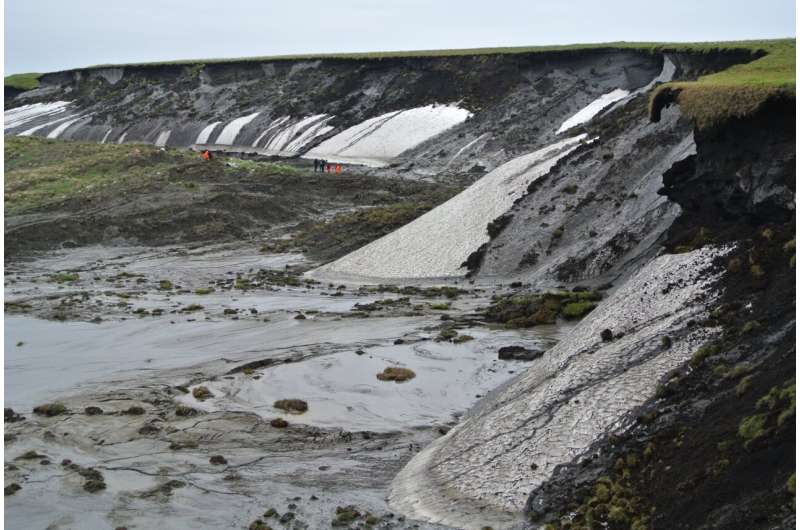This article has been reviewed according to Science X's editorial process and policies. Editors have highlighted the following attributes while ensuring the content's credibility:
fact-checked
peer-reviewed publication
trusted source
proofread
Thawing permafrost: Research suggests it's not a climate tipping point, but nevertheless has far-reaching impacts

Permafrost soils store large quantities of organic carbon and are often portrayed as a critical tipping element in the Earth system, which, once global warming has reached a certain level, suddenly and globally collapses. Yet this image of a ticking timebomb, one that remains relatively quiet until, at a certain level of warming, it goes off, is a controversial one among the research community.
Based on the scientific data currently available, the image is deceptive, as an international team led by the Alfred Wegener Institute has shown in a recently released study.
According to their findings, there is no single global tipping point; rather, there are numerous local and regional ones, which "tip" at different times, producing cumulative effects and causing the permafrost to thaw in step with climate change. As such, taking decisive action today is all the more important if our goal is to preserve as much permafrost as possible. The study was released in the journal Nature Climate Change.
Permafrost ground covers roughly a quarter of the landmass in the Northern Hemisphere and stores tremendous quantities of organic carbon in the form of dead plant matter. As long as it remains frozen, this matter remains intact—but when permafrost thaws, microorganisms begin breaking it down, releasing large amounts of carbon into the atmosphere as CO2 and methane.
Accordingly, rising temperatures worldwide could activate this massive reservoir and substantially worsen climate change through additional emissions. Consequently, in the public debate you'll frequently encounter the idea of a "ticking carbon timebomb."
This is based on the assumption that the permafrost, like the Greenland Ice Sheet, is one of several tipping elements in the Earth system. In this view, permafrost will initially experience only gradual thawing in response to global warming; then, once a critical threshold value is surpassed, the thawing processes will suddenly begin amplifying one another, leading to the rapid and irreversible collapse of permafrost across the Arctic.
Though many have speculated that this type of thawing scenario is possible, to date it has remained unclear whether there really is any such threshold value, and if so, what the corresponding temperature limit is.
An international research team led by Dr. Jan Nitzbon from the Alfred Wegener Institute, Helmholtz Center for Polar and Marine Research (AWI) has now gotten to the bottom of this question.
"In fact, the idea of permafrost being a global tipping element is a controversial one in the research community. The IPCC also pointed out this uncertainty in its latest Assessment Report," says the AWI expert.
"Our goal was to close this gap in our knowledge. For our study, we compiled the available academic literature on those processes that can influence and accelerate the thawing of permafrost. Combining it with our own data analysis, we assessed all current findings on thawing processes in terms of whether and, if so, on which spatial scale—local, regional, global—they could lead to self-perpetuating thawing and therefore to a 'tipping' in connection with a given level of warming."
The study's findings are clear: there are indeed geological, hydrological and physical processes that are self-amplifying and, in some cases, irreversible; however, these are acting only locally or regionally. One example: the formation of what are known as thermokarst lakes. Here, the ice inside permafrost soils melts, creating depressions.
The meltwater collects at their surface, producing a dark lake that absorbs large quantities of solar energy. This in turn intensifies the warming of permafrost underneath the water, creating a self-sustaining thawing process in and around the lake. They also found similarly amplifying feedbacks in other permafrost-relevant processes, like the loss of boreal conifer forests due to fire—but here, too, only at the local to regional scale.
"There is no evidence of self-amplifying internal processes that, from a certain degree of global warming, affect all permafrost and accelerate its thawing globally," Nitzbon explains.
"Moreover, the projected release of greenhouse gases wouldn't lead to a global upsurge in warming by the end of the century. As such, portraying the permafrost as a global tipping element is misleading."
But that doesn't mean Arctic permafrost is nothing to worry about—on the contrary, the study clearly shows that the permafrost zone is very heterogenous. Consequently, numerous small, local tipping points will be exceeded at different times and warming levels, accumulating over time.
As a result, the global thawing of permafrost will not constitute a gradual increase followed by a sudden surge; rather, it will intensify in step with global warming, ending with the total loss of the permafrost once global warming reaches 5 to 6 degrees Celsius.
"That means more and more regions are already or soon will be inevitably affected by thawing," says the AWI researcher.
"In other words, there is no safety margin of warming—as the image of the tipping point suggests—that we can still exploit as long as we don't exceed the threshold value.
"That's why we need to keep a close eye on the permafrost regions through even better monitoring, gain a better grasp of the processes involved, and represent them in climate models to further reduce the sources of uncertainty. And one more thing is clear with regard to the greenhouse-gas emissions-based permafrost loss: the sooner that humankind can achieve net-zero emissions, the more regions can be preserved as unique habitats and carbon reservoirs."
More information: No respite from permafrost-thaw impacts in the absence of a global tipping point, Nature Climate Change (2024). DOI: 10.1038/s41558-024-02011-4
Journal information: Nature Climate Change
Provided by Alfred Wegener Institute



















